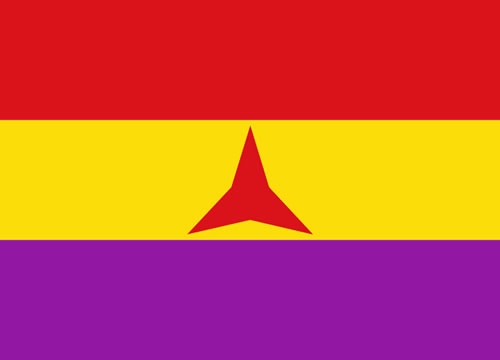Since old posts are no longer accessible, I will be posting the preface of Davies and Wheatcroft's The Years of Hunger, a scholarly work by mainstream historians, in the comments. The full work is available on Sci-Hub, but it isn't really about debunking the nazi's holodomor narrative. It covers the Soviet famine of the 1930's, the last in a long series of famines in that part of the world. The preface is the only part that is specifically dedicated to debunking, and the explanations for that are in the text of the preface. I found this work in an old post on here while debate-broing on Discord with a bunch of European liberals utterly convinced that Stalin had personally eaten all the grain with his giant spoon. Maybe this can help you when liberals try to label you a genocide denialist.
:soviet-chad:
I'm pretty sure the common historical consensus even among academic historians is that it is not a genocide.
Yes, even as lib as r/AskHistorians is, the actual historians there who comment on it say it wasn't a genocide and Stalin never specifically tried to wipe out Ukrainians.
Yes, that's what I was hoping this could help demonstrate. Even the old anti-Soviet historian Conquest doesn't call it a genocide.
Isn't there a parliament you forgot to ask? :amerikkka: :ukkk: :ukkkraine: :aus-delenda-est:
:reddit-logo: is probably be the biggest misinformation website, you would think the fact checkers and misinformation police would be concerned.
How many Westerners died during the Great Depression? Based on what I can tell from the sum of western scholarship, the answer is: zero! In fact, things were so great people un-died. Everyone just went to the soup kitchen and got free food and it was all fine. Best decade of all time.
So, does anybody know the real number? There were literally millions of people who lost their homes. I'm supposed to believe that, uh, only 20 of them died?
The frustrating part about researching this is that dying of preventable malnutrition isn't regarded as dying because of the depression. Most literature I've seen on the topic is mortality rates actually dropped in the USA between 1929 and 1939 except regarding suicides. Life expectancy between 1920 and 1940 actually rose by 9 years among Americans.
Which to be fair, is probably because that's when everyone started getting vaccinated against tuberculosis. The vaccine was invented in 1921. It can't be overstated how many people died of TB, something like 80% of people in North America used to be infected with it, you had a 5 to 10% chance of developing active symptoms, and you had an 80% chance of dying if your TB went active. The vaccine basically eradicated tuberculosis from North America and now hardly anyone gets it. Used to be a top 5 cause of death.
That's part of why it's difficult to gauge these numbers. It's also difficult because the majority of people impacted by the great depression were poor and rural, and many of the victims were very young children. The USA didn't give much of a shit about formal census records of rural people until kinda recently. Birth certificates weren't issued until 1902, and weren't made federally standard until 1946. My great-grandmother born in 1896 didn't have a birth certificate and sometimes she'd brag about it.
I've also read an interesting theory about why life expectancy actually rises during big American recessions. Less work typically means less strenuous labor, fewer industrial accidents, less alcohol consumption and smoking, and more hours of sleep per night. Also means fewer cars on the road. America is such a stupid fucking country that economic recessions are actually good for public health?
Nope, sorry, Princeton say the Great Depression made people live longer, which means nobody died.
the US was an exporter with relatively little subsistence production, at least not out by the dust bowl. so the plains crop failures weren't not feeding americans so much as whoever was buying it---and with price collapses crops might not've been exported anyway. one could maybe relate it to international famines but that gets really tricky talking about logistics, purchasing power and foreign aid
It would be great if someone made a comprehensive list of other crises analyzed through the same methodology that gives the upper estimates for the great Chinese famine.
There's so much propaganda around the history of the 30s that it took decades for me to notice the US had a famine and we were just all agreeing to not talk about what really happened.
I actually brought up this idea on hexbear once. Someone did question whether the situation in the US was severe enough to warrant being called a famine. I'm just a cynical hater, but I suspect it was quite bad.
I guess, as with most famines, we don't always have all of the details on the suffering.
PREFACE TO REVISED EDITION
Since this book was completed, the Soviet famine of 1931–33 has become an international political issue. Following a number of preliminary declarations and a vigorous campaign among Ukrainians in Canada, in November 2006 a bill approved by the Ukrainian parliament (Verkhovna rada) stated that the famine was ‘an act of genocide against the Ukrainian people’. In the following year a three-day event commemorating the famine in Ukraine was held in its capital, Kiev, and at the same time Yushchenko, the president, called on the Ukrainian parliament to approve ‘a new law criminalising Holodomor denial’ – so far without success.1 Then on May 28, 2008, the Canadian parliament passed a bill that recognised the Holodomor as a genocide and established a Ukrainian Famine and Genocide (‘Holodomor’) Memorial Day. Later in the year, on October 23, 2008, the European parliament, without committing itself to the view of the Ukrainian and Canadian parliament that the famine was an act of genocide, declared it was ‘cynically and cruelly planned by Stalin’s regime in order to force through the Soviet Union’s policy of collectivization of agriculture’. In the following month, on the 75th anniversary of what it described as ‘the famine-genocide in Ukraine’, the Ukrainian Canadian Congress held a widely publicised National Holodomor Awareness Week.
This campaign is reinforced by extremely high estimates of Ukrainian deaths from famine. On November 7, 2003, a statement to the United Nations General Assembly by 25 member-countries declared that ‘the Great Famine of 1932–1933 in Ukraine (Holodomor) took from 7 million to 10 million innocent lives’. According to Yushchenko, Ukraine ‘lost about ten million people as a direct result of the Holodomor-genocide’. The President of the Ukrainian World Congress insisted in a statement to the United Nations that ‘a seven–ten million estimate appears to present an accurate picture of the number of deaths suffered by the Ukrainian nation from the Great Famine (Holodomor) of 1932–33’.2 In contrast, the Russian government has consistently objected to the Ukrainian view. On April 2, 2008, a statement was approved by the Russian State Duma declaring that there was no evidence that the 1933 famine was an act of genocide against the Ukrainian people. The statement condemned the Soviet regime’s ‘disregard for the lives of people in the attainment of economic and political goals’, but also declared that ‘there is no historic evidence that the famine was organized on ethnic grounds’. The official view was endorsed by the Russian archives, and by Russian historians. In 2009 the Russian Federal Archive Agency published a large handsome book reproducing photographically 188 documents from the archives, to be followed by several further volumes.3 In the preface the director of the Russian archives, V. P. Kozlov, criticises the ‘politicisation’ of the famine:
Not even one document has been found confirming the concept of a ‘golodomor-genocide’ in Ukraine, nor even a hint in the documents of ethnic motives for what happened, in Ukraine and elsewhere. Absolutely the whole mass of documents testify that the main enemy of Soviet power at that time was not an enemy based on ethnicity, but an enemy based on class.4
In our own work we, like V. P. Kozlov, have found no evidence that the Soviet authorities undertook a programme of genocide against Ukraine. It is also certain that the statements by Ukrainian politicians and publicists about the deaths from famine in Ukraine are greatly exaggerated. A prominent Ukrainian historian, Stanislas Kul’chitskii, estimated deaths from famine in Ukraine at 3–3.5 million;5 and Ukrainian demographers estimate that excess deaths in Ukraine in the whole period 1926–39 (most of them during the famine) amounted to 31⁄2 million.6 Nevertheless, Ukrainian organisations continue, with some success, to urge Canadian schools to teach as a fact that excess deaths were 10 million during the 1932–33 famine.7 This does not mean that Ukraine did not suffer greatly during the famine. It is certainly the case that most of the famine deaths took place in Ukraine, and that the grain collection campaign was associated with the reversal of the previous policy of Ukrainisation.8 In this context Russian interpretations of the famine differ greatly. At one extreme doughty supporters of the Stalinist regime claim that the famine was an act of nature for which Stalin and the Soviet government were not responsible. Thus in his recent book on the famine a Russian publicist, a certain Sigizmund Mironin, argued that the very poor harvest of 1932 was the main cause of the famine:
Using the articles of M.Tauger and other English-language sources, I seek to prove: 1) there was a very bad harvest in 1932, which led to the famine; 2) the bad harvest was caused by an unusual combination of causes, among which drought played a minimum role, the main role was played by plant diseases, unusually widespread pests, and the lack of grain connected with the drought of 1931, and rain during the sowing and harvesting; 3) the bad harvest led to a severe famine ... 4) the Soviet leadership, and Stalin in particular, did not succeed in receiving information about the scale of the famine; 5) Stalin and the Politburo, as a result of the drought in 1931, did not have grain stocks, but did everything they could to reduce human losses from the famine, and took every measure to prevent famine from recurring.9
This view of the famine is emphatically and justifiably rejected by most Russian historians. We show in the following pages that there were two bad harvests in 1931 and 1932, largely but not wholly a result of natural conditions. But the 1932 harvest was not as bad as Mark Tauger has concluded (see pp. xix–xx below). Stalin was certainly fully informed about the scale of the famine. Moreover, Mironin’s account neglects the obvious fact that the famine was also to a considerable extent a result of the previous actions of Stalin and the Soviet leadership. Mironin’s book is Stalinist apologetics, not history. Unfortunately this approach to the Stalin era is increasingly publicised in contemporary Russia.
The prevailing view among Russian historians, in contrast, is that this was an ‘organised famine’, caused by Stalin and his entourage as part of the war against the peasantry throughout the USSR. The outstanding historian of the Russian peasantry, the late Viktor Danilov, together with his colleague Zelenin, in an article in a major historical journal ‘written on the 70th anniversary of the general tragedy of the peasantry’, put this view forcefully.10 They claimed that in 1932–33 there was ‘a kind of chain of mutually connected and mutually dependent Stalin actions (fully or not fully conscious) to organise the “great famine” ’. Thus the law of August 7, 1932, imposing the death penalty for the theft of kolkhoz grain, was followed on November 27 by Stalin’s declaration that those peasants who ‘supported the sabotage of the grain collections’ should be answered with a ‘crushing blow’; then on December 27 internal passports were introduced, designed to prevent peasants moving to the towns, and on January 22, 1933, an infamous directive banned the movement of peasants from Ukraine and the North Caucasus to other areas.11 Western commentators and historians long debated whether the famine was man-made. They differ in their assessments of the extent to which Soviet policy was responsible for the famine and the extent to which Terror was consciously used by the state. In response to the first edition of our book Robert Conquest, the most widely cited advocate of the view that the famine was man-made, has clarified his position on this matter and has clearly stated that although he thinks that the famine was caused by the Bolsheviks, who engaged in criminally terroristic measures, he nevertheless does not think that it was consciously intended (see note 145 on page 441 below).12 Danilov and Zelenin concurred that Stalin did not want or anticipate a famine, but they characterised it as an ‘organised famine’, while also describing Stalin’s actions as being ‘fully or not fully conscious’. We think that this is a misleading way of looking at the problem. We do not think it appropriate to describe the unintended consequences of a policy as ‘organised’ by the policy-makers. Russian historians sometimes call the famine ‘rukotvornyi’ – man-made – on the grounds that it was ultimately a result of the forcible collectivisation of agriculture, and that is more defensible. But in our opinion they and Conquest underestimate the role of climate and other natural causes in producing the bad harvests of 1931 and 1932, and are mistaken in believing that the 1932 harvest was an average harvest rather than a poor one. The two successive bad harvests in 1931 and 1932, partly resulting from the previous policies of the Soviet leadership, meant that by the spring of 1932 there was an absolute shortage of grain, which became more severe in the ensuing twelve months. This was a central feature of a general crisis in 1932–33. The Soviet leaders were faced with major problems throughout the economy, which led to another chain of ‘mutually connected and mutually dependent Stalin actions’, parallel with that described by Danilov and Zelenin.
First, the Japanese aggressive policy towards the Soviet Union, culminating in the invasion of Manchuria in September 1931, led to the Soviet decision to increase defence preparation. Secondly, the world economic crisis involved a major turn of the terms of trade against Soviet agricultural and other exports. In 1931 imports greatly exceeded exports, and the foreign debt increased by 50 per cent in that single year. Thirdly, the food shortage in the towns, serious since 1929, grew much worse under the impact of the flood of labour into industry in 1931.
There was no easy way to cope with these developments, and the Politburo had to modify greatly its original aims. The defence plans launched in the autumn of 1931 had to be cut back halfway through 1932, and remained in a reduced form in spite of the advent of Hitler to power in January 1933. Imports for the industrialisation programme had also to be cut drastically in 1932 and 1933, affecting such major projects as the Chelyabinsk tractor factory. And additional grain for the towns was not available. As early as the spring of 1932 the Soviet authorities planned not to increase the state grain collections from the 1932 harvest, and eventually they were able to procure only 18.5 million tons as compared with the 22.8 million tons obtained from the 1931 harvest. Rations in the towns were drastically cut back, and in the winter and spring of 1932–33 many townspeople were starving. For the first time since the early 1920s, in 1933 the number employed in the non-agriculture sector was reduced, including the number employed in industry and on the railways, and investment was reduced for the first time since the early 1920s. The crisis had forced Stalin and the Politburo to retreat ignominiously. Stalin’s clarion call of February 1931 to close the gap between the USSR and the advanced countries within ten years, ‘or they will do us in’, could not now be honoured. These were desperate and brutal men trying to cope with a crisis, not organisers of a deliberate famine.13
However, as we conclude on the last page of our text, ‘we do not at all exempt Stalin from responsibility for the famine’. Historians will continue to debate whether dekulakisation and the forcible collectivisation of agriculture were ‘necessary’. We ourselves take the view that a policy of rapid industrialisation aimed at establishing modern heavy and defence industries was incompatible with the New Economic Policy of the 1920s, with its mixed economy and the market relationship with the peasantry. It required a move towards much greater central control of the economy in general and of agriculture in particular. But it is also certain that contemporary critics of Stalin’s policy such as Syrtsov were justified.14 The version of rapid industrialisation adopted by Stalin and the Politburo involved the excessive use of force against its real and imagined opponents, particularly in the countryside. It was far too optimistic both about the possible rate of industrial growth, and about the agricultural progress which would immediately follow from collectivisation. It assumed that collective agriculture would thrive even though horses had not been supplemented by tractors on a major scale. Moreover, it was taken for granted that the grain harvest would increase annually, while in fact natural conditions in the Soviet Union made periodic poor harvests inevitable. The good harvest of 1930 led to the decisions to export substantial amounts of grain in 1931 and 1932. The Soviet leaders also assumed that the wholesale socialisation of livestock farming would lead to the rapid growth of meat and dairy production. These policies failed, and the Soviet leaders attributed the failure not to their own lack of realism but to the machinations of enemies. Peasant resistance was blamed on the kulaks, and the increased use of force on a large scale almost completely replaced attempts at persuasion. Largely through their own fault, the Politburo had led the economy into an impasse. By the time the famine was looming over the country at the end of 1932, only an appeal for foreign assistance through grain imports would have stood any chance of avoiding famine. The Politburo did not even contemplate the public admission of failure which this would entail.
Since our book was published, some of its conclusions have been the subject of strenuous criticism, especially from Mark Tauger and Michael Ellman, writing from very different positions. Ellman concurs that some deaths were caused by ‘exogenous non-policy-related factors’ such as the drought of 1931, and that others were ‘unintended consequences of policies with other objectives’ including the ‘tribute model of rapid industrialisation’. But he also claims that some deaths were the deliberate result of what he called ‘the starvation policy of 1932–33’. Tauger claims on the basis of kolkhoz reports that the harvest of 1932 was as low as 50 million tons with an average yield of 5.2 tsentners per hectare, and that our criticism of his estimate as too low is mistaken. In view of his low estimate of the harvest, Tauger interprets the 1932–33 famine as ‘the largest in a series of natural disasters’.15 In a reply to Tauger, Wheatcroft apologises on our behalf for an error in our calculations of the 1932 yield based on kolkhoz reports, and in the present edition of our book (pp. 444–5) we have replaced our previous estimate of the grain yield based on these reports, 6.2 tsentners per hectare, by a new estimate, 5.8 tsentners.16 This gives grain production in the 1932 harvest derived from kolkhoz reports as in the range 55–7 million tons. We had also made alternative estimates, which fall within the same range. See for example our estimate based on the secret Soviet grain-fodder balances, p. 447 below. Our general conclusion remains that the 1932 was between 55 and 60 million tons, a low harvest, but substantially higher than Tauger’s 50 million.
In a further contribution to the discussion, Hiroaki Kuromiya judiciously summarises his provisional conclusions about various strands of these Ukrainian, Russian, and international debates: Although Stalin intentionally let starving people die, it is unlikely that he intentionally caused the famine to kill millions of people. It is also unlikely that Stalin used famine as a cheap alternative to deportation. True, the famine affected Ukraine severely; true, too, that Stalin distrusted the Ukrainian peasants and Ukrainian nationalists. Yet not enough evidence exists to show that Stalin engineered the famine to punish specifically the ethnic Ukrainians. The famine did not take place in an international political vacuum. The sharp rise in the foreign threat was likely to have been an important aggravating factor. These debates may be followed in the journal Europe-Asia Studies.17 Since the first publication of this volume, our colleague Viktor Danilov has died. We take this opportunity to express our gratitude for his enormous contribution to peasant studies, and for his staunch friendship over thirty years, in good times and bad.
June 2009 RWD
SGW
1 ‘Holodomor’ – a Ukrainian word meaning ‘death by hunger’ (in Russian rendered as ‘golodomor’).
2 See http://www.ucc.ca/holodomor/files/IHC-The-Case-for-7-Million (accessed April 29, 2009).
3 Golod v SSSR 1930-1934; Famine in the USSR 1930–1934 (2009), 518 pp.
4 Op. cit. 7.
5 S. Kul’chitskii, Pochemu ON nas unichtozhil? Stalin i ukrainskii golodomor (Kiev, 2007), 120.
6 Demografichna katastrofa v Ukraini vnaslidok golodomoru 1932–1933 rokiv: skladovi, masshtabi, naslidki, Institut Demografii ta sotsial’nykh doslidzhen’, Natsional’na akademiya nauk Ukraini (Kiiv, 2008), 76, 82, 84. For our own lower estimate, see pp. 412–17 below.
7 See for example the school syllabus in http://faminegenocide.com/resources/ teachingkuryliw.html (accessed April 30, 2009).
8 See below, pp. 190–1, 413–14.
9 S. Mironin, ‘Golodomor’ na Rusi (2008), 9–10 (a 221 page book, published in 5,000 copies).
10 V. P. Danilov and I. E. Zelenin, ‘Organizovannyi golod’, OI, 6, 2004, 97–111, especially p. 108. This view is broadly endorsed by the principal Russian specialist on the famine, Viktor V. Kondrashin – see his Golod 1932–1933 godov: tragediya Rossiiskoi derevni (2008), especially p. 376, where he writes (somewhat cautiously) that ‘it may be defined as an “organised famine” ’.
11 These measures are described below on pp. 163–8, 187–8, 426–7, and in vol. 4 of this series, pp. 290–1.
12 It is regrettable that many of the advocates of the genocide thesis continue to claim Conquest to justify their position, despite his clearly expressed views on this matter. See the Harvard Ukrainian Research Institute Conference on Holodomor on November 18, 2008, http://www.huri.harvard.edu/na/2008_11_17-18_famine_ conf/2008_11_18_werth-graziosi-flier.html (accessed May 18, 2009). At the conference Nicolas Werth was asked by a participant in the conference, who had attended a lecture given by Wheatcroft, whether Conquest accepted the view that the famine was genocide. Werth strangely replied that ‘we all know in scientific circles the very complicated relations between Conquest and Wheatcroft’; he repeated this several times, but declined to reply to the question. Kul’chitskii more straightforwardly has explained that in June 2006 a Ukrainian delegation of experts on the Holocaust and the Golodomor met Robert Conquest in Stanford University and enquired about his views, and were told directly by him that he preferred not to use the term genocide (Kul’chitskii (2007), 176).
13 For these developments, see vol. 4 of this series: R. W. Davies, Crisis and Progress in the Soviet Economy, 1931–1933 (1996), pp. 164–76 (defence), 118–21, 155–64 (foreign trade and import cuts), 176–92 (food shortage), 419, 539 (reduction in nonagricultural employment).
14 For Syrtsov’s views, see vol. 3 of this series, The Soviet Economy in Turmoil, 1929–1930 (1989), especially pp. 400–3, 411–15, and Oleg Khlevniuk’s article in The Lost Politburo Transcripts (New Haven and London, 2009), especially pp. 86–92.
15 Tauger, The Carl Beck Papers, no. 1506 (2001), 46.
16 For the revised table of grain production by region, see http://www.sovietarchives- research.co.uk/hunger and Europe-Asia Studies, vol. 59, 864–6. Some misprints and minor errors elsewhere in our book have also been corrected in the present edition.
17 Vol. 57 (2005), 823–41 (Ellman), vol. 58 (2006), 625–33 (Davies and Wheatcroft), 973–84 (Tauger), vol. 59 (2007), 663–93 (Ellman), 847–68 (Wheatcroft), vol. 60 (2008), 663–75 (Kuromiya), and vol. 61 (2009), 505–18 (D. R. Marples).
Thus in his recent book on the famine a Russian publicist, a certain Sigizmund Mironin, argued that the very poor harvest of 1932 was the main cause of the famine:
I think you're missing a new paragraph after this to show that it's a block quote like the one from Kozlov. Also might want to use > for those block quotes to make it easier to distinguish from the main body of the text. Good stuff overall
Thank you. I had saved this to a notepad file a while ago because it was too long to post on Discord and lost a lot of the formatting.
Much thanks for this!
I also thought this 1988 article on the topic was pretty excellent: https://www.villagevoice.com/2020/11/21/in-search-of-a-soviet-holocaust/
can't find a primary source for this bit
“There is no evidence it was intentionally directed against Ukrainians,” said Alexander Dallin of Stanford, the father of modern Sovietology. “That would be totally out of keeping with what we know — it makes no sense.”
It's the least I can do now that all of the NATO fascists are marching to the Ukrofascists' drum.
this is awesome..thank you!! i wonder if there's anything similar to this but for the "rape of berlin" that the red army is accused of committing after ww2?
I think there is one called something like "the rape of germany," which goes over the atrocities all of the allied forces' armies committed in Germany. I haven't read it and don't have it handy, but I'll try looking for it later.
The author Antony Beevor originated/popularized this. When I tried looking into it I found that he was a NED adjacent historian, and that he was selective with his postwar interviews that he bases the rape of berlin on (think of the narratives that would exist in West Germany with a ramping-up Cold War propaganda campaign). All other claims seem to be sourced back to him, which I also found odd.
That being said lack of credible information doesn't mean that it didn't happen.
Anyone see that review from the academic on Anne Applebaum's book? He just completely dismantled it
the last in a long series of famines in that part of the world
Sorry I don't remember where I heard it, but my understanding is that Russia in the 19th century experienced 5 major famines that together killed about 40 million people.







